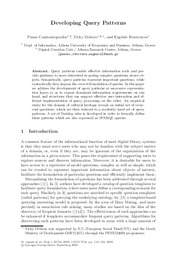| dc.contributor.author | Κωνσταντόπουλος, Πάνος | el_GR |
| dc.contributor.author | Δρίτσου, Βίκυ | el_GR |
| dc.contributor.author | Φουστούκου, Ευγενία | el_GR |
| dc.contributor.author | Constantopoulos, Panos | en |
| dc.contributor.author | Dritsou, Vicky | en |
| dc.contributor.author | Foustoucos, Eugenie | en |
| dc.coverage.spatial | GR - Κέρκυρα | en |
| dc.date.available | 2014-02-27T07:01:58Z | |
| dc.date.issued | 2009 | |
| dc.identifier.uri | http://hdl.handle.net/10797/13875 | en |
| dc.description | Περιέχει το πλήρες κείμενο | el_GR |
| dc.description.abstract | Query patterns enable effective information tools and provide
guidance to users interested in posing complex questions about objects.
Semantically, query patterns represent important questions, while
syntactically they impose the correct formulation of queries. In this paper
we address the development of query patterns at successive representation
layers so as to expose dominant information requirements on one
hand, and structures that can support effective user interaction and efficient
implementation of query processing on the other. An empirical
study for the domain of cultural heritage reveals an initial set of recurrent
questions, which are then reduced to a modestly sized set of query
patterns. A set of Datalog rules is developed in order to formally define
these patterns which are also expressed as SPARQL queries. | en |
| dc.language.iso | eng | en |
| dc.relation.ispartof | Knowledge Organization Systems | en |
| dc.rights | info:eu-repo/semantics/openAccess | en |
| dc.source | 13th European Conference, ECDL 2009 | en |
| dc.title | Developing Query Patterns | en |
| dc.type | Conference Object | en |
| dc.subject.JITA | Τεχνικές υπηρεσίες σε βιβλιοθήκες, αρχεία και μουσεία | el_GR |
| dc.subject.JITA | Technical services in libraries, archives and museums | en |
| dc.contributor.conferenceorganizer | Τμήμα Αρχειονομίας και Βιβλιοθηκονομίας, Εργαστήριο Ψηφιακών Βιβλιοθηκών και Ηλεκτρονικής Δημοσίευσης, Ιόνιο Πανεπιστήμιο | el_GR |
| dc.identifier.JITA | JZ | en |
